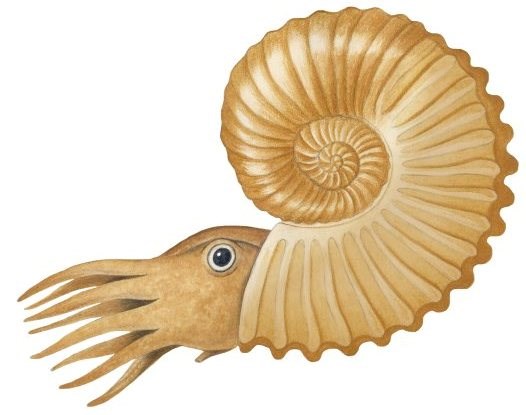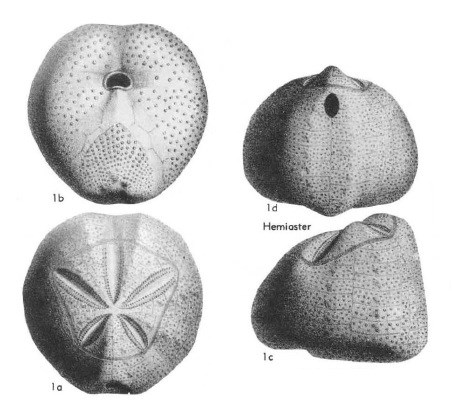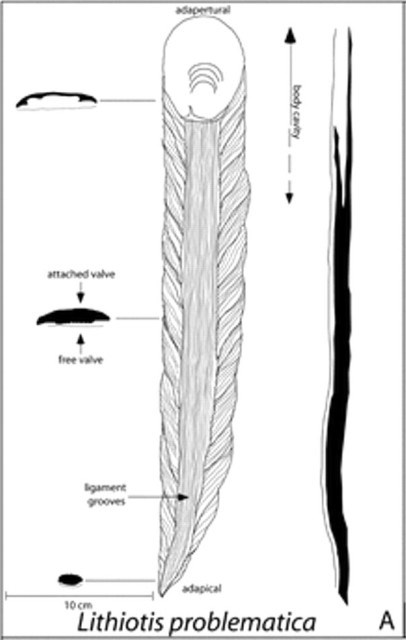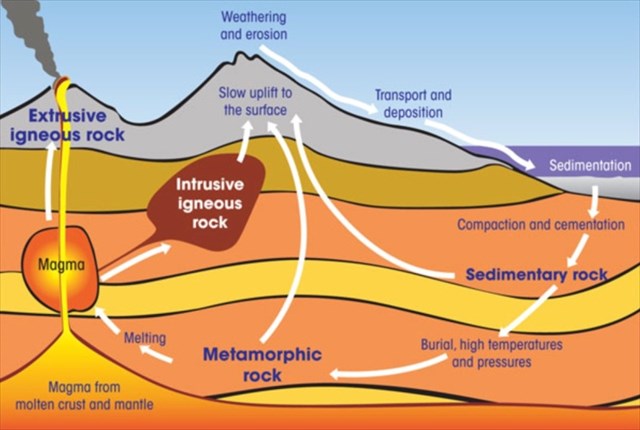
At the listed coordinates you will find beautiful black and white rock at columns at the entrance to the Europa cinema. This black and white rock is actually black rock that is speckled with numerous white fossils of one type of marine animals. The rock is formed during the Early Cretaceous epoch and its origin is from Croatian region of Lika.
Fossils
Fossils are accidental by-products of life preserved in the geological record. They can be formed in all sorts of ways by the processes of nature. Life comes in a wide variety of forms and shapes and so therefore do fossils. Since each life-form can be fossilized in several different ways the variety found in fossils is amazing.
Some of the marine animals that often can be found as fossils are ammonites, sea urchins and bivalve mollusks.
Ammonites are group of marine animals that are completely extinct today. They are closely related to today’s octopuses and squids. The earliest ammonites appear during the Devonian Period. They went extinct at the end of the Cretaceous period during the Cretaceous–Paleogene extinction event, the same mass extinction event that wiped out dinosaurs. They are excellent index fossils, and it is often possible to link the rock layer in which a particular species or genus is found to specific geologic time periods.
Ammonite - Australiceras jacki
 Source: Australian Museum (australianmuseum.net.au).
Source: Australian Museum (australianmuseum.net.au).
Sea urchins are small, spiny, globular marine animals that today count about 250 species around the world. Their earliest fossils are from the upper part of the Ordovician period (about 450 million years ago). They almost went extinct at the end of the Paleozoic era and only six species survived that period. The sea urchins flourished during the Mesozoic and Cenozoic eras. Most sea urchin fossils are often abundant in the restricted areas and in formations where they occur.
Sea urchin - Hemiaster
 Source: Catalogue of Organisms (coo.fieldofscience.com).
Source: Catalogue of Organisms (coo.fieldofscience.com).
Bivalves are marine and freshwater molluscs that have laterally compressed bodies enclosed by a shell consisting of two hinged parts. Bivalves appear in the fossil record first in the early Cambrian more than 500 million years ago. Bivalve fossils are formed when the sediment in which the shells are buried hardens into rock. Often, the impression made by the valves remains as the fossil rather than the valves. During the Early Ordovician, a great increase in the diversity of bivalve species occurred, and the dysodont, heterodont, and taxodont dentitions evolved.
Bivalve – Lithiotis problematica
 Source: Nicole M. Fraser, David J. Bottjer, Alfred G. Fischer, "Dissecting “Lithiotis” Bivalves: Implications for the Early Jurassic Reef Eclipse", PALAIOS, vol. 19, no. 1, pp. 51-67, 2004.
Source: Nicole M. Fraser, David J. Bottjer, Alfred G. Fischer, "Dissecting “Lithiotis” Bivalves: Implications for the Early Jurassic Reef Eclipse", PALAIOS, vol. 19, no. 1, pp. 51-67, 2004.
Fossils and Types of Rocks
In general, there are three basic types of rocks: igneous, sedimentary, and metamorphic. Because these three types of rocks differ significantly in the way they are formed, you will also have quite different chances to find fossils in rocks from different types.
Igneous rocks are formed when molten rock cools. In that process, rock changes from a liquid to a solid. The cooling of the molten rock can occur underground or above ground. If it happens underground, the molten rock is called magma and igneous rock is called intrusive or plutonic. If the cooling process occurs above ground, the molten rock is called lava and the igneous rock is called extrusive or volcanic rock. The temperatures involved in the formation of igneous rocks are too high for the preservation of fossils.
Sedimentary rocks are composed of pieces of other rocks. When any rock is exposed to the elements (sunlight, wind, water) it is eventually broken down into smaller particles. These particles are moved the surface by gravity, water, ice and wind. After some time they eventually settle somewhere and then they are glued together by the process of cementation. During the process of formation of sedimentary rocks animals and plants may get trapped in the sediment and fossils of those animals and plants may be found in sedimentary rocks.
Metamorphic rocks start as either igneous, sedimentary or preexisting metamorphic rocks and undergo a major change that is called metamorphosis. The change of preexisting rocks is caused by high pressure and/or high levels of heat. Metamorphism can happen in one of three ways: by contact with heat, by burial under rocks and sediment, and by direct pressure and heat from plate collisions. Metamorphic rocks may in some cases contain fossils if they were formed from sedimentary rocks, but the fossils in that case are broken and squashed by the process of metamorphism.
Types of Rocks
 Source: Forbes.com
Source: Forbes.com
Logging Tasks
To log this EarthCache answer the following questions:
1. Describe the fossils that you see at EarthCache location.
2. Based on your observation of fossils at EarthCache location, do you think these fossils are from ammonites, sea urchins or bivalve mollusks?
3. Based on your observation of fossils at EarthCache location, do you think this rock is igneous, sedimentary or metamorphic? Why?
Send your answers through my profile at geocaching.com (through e-mail or message center) and NOT in a log. You don't have to wait for me to approve your answers. Once you send your answers feel free to log this EarthCache as found. If there are problems with your answers, I will contact you.
Sources
1. Fossils, Course Notes, EarthCache Academy.
2. Alecia M. Spooner, Geology for Dummies, Hoboken: Wiley Publishing, Inc., 2011.
3. Monica Price and Kevin Walsh, Rocks and Minerals, London: Dorling Kindersley, 2005.
4. Nicole M. Fraser, David J. Bottjer, Alfred G. Fischer, "Dissecting “Lithiotis” Bivalves: Implications for the Early Jurassic Reef Eclipse", PALAIOS, vol. 19, no. 1, pp. 51-67, 2004.
5. Zagrebackim ulicama... Zagreb u kamenu, Zagreb: Croatian Natural History Museum, 2014.
6. Wikipedia.org

Na izlistanim koordinatama pronaći ćete lijep, crno-bijeli kamen na stubovima kod ulaza u kino Europa. Ovaj crno-bijeli kamen je u stvari crni kamen koji je prošaran brojnim bijelim fosilima jedne vrste morskih životinja. Kamen je nastao tijekom epohe Donje Krede na području Like.
Fosili
Fosili su slučajni nusproizvodi života očuvani u geološkom materijalu. Fosili mogu nastati na različite načine pomoću prirodnih procesa. Život se javlja u raznim oblicima, pa se stoga i fosili javljaju u različitima oblicima. S obzirom da se svaki oblik života može fosilizirati na nekoliko načina, među fosilima postoji nevjerojatna raznolikost.
Neke od morskih životinja koje se često mogu naći kao fosili su amoniti, morski ježinci i školjkaši.
Amoniti su grupa morskih životinja koja su danas u potpunosti izumrle. Bliski su rođaci današnjim hobotnicama i lignjama. Najraniji primjerci amonita javljaju se tijekom Devona. Izumrli su na kraju perioda Krede tijekom Kredsko-tercijarskog masovnog izumiranja, istog masovnog izumiranja tijekom kojega su izumrli i dinosauri. Amoniti su odlični indeksni fosili koji omogućavaju da se sloj stijena u kojima se pronađu fosili određene vrste amonita poveže s točno određenim geološkim razdobljem.
Amonit - Australiceras jacki
 Izvor: Australian Museum (australianmuseum.net.au).
Izvor: Australian Museum (australianmuseum.net.au).
Morski ježinci su malene, trnovite, okrugle morske životinje od kojih danas postoji oko 250 vrsta diljem svijeta. Njihovi najraniji fosili su iz perioda Gornjeg Ordovicija (prije 450 milijuna godina). Gotovo su izumrli na kraju ere Paleozoika i samo je šest vrsta preživjelo to razdoblje. Osobito su se razvili tijekom Mezozoika i Kenozoika. Većina fosila morskih ježinaca se može naći u velikim količinama u ograničenim područjima u kojima su živjeli.
Morski ježinac - Hemiaster
 Izvor: Catalogue of Organisms (coo.fieldofscience.com).
Izvor: Catalogue of Organisms (coo.fieldofscience.com).
Školjkaši su morski i slatkovodni mekušci koji imaju bočno komprimirana tijela zatvorena u školjku koja se sastoji od dva povezana dijela. Najstariji fosili školjkaša su iz ranog Kambrija, prije više od 500 milijuna godina. Fosili školjkaša nastaju kada sediment u koji su školjkaši ukopani postane stijena. Često, kao fosil je očuvan otisak školjke, a ne sama školjka. Tijekom Ranog Ordovicija došlo je do naglog povećanja u broju vrsta školjkaša.
Školjkaš – Lithiotis problematica
 Izvor: Nicole M. Fraser, David J. Bottjer, Alfred G. Fischer, "Dissecting “Lithiotis” Bivalves: Implications for the Early Jurassic Reef Eclipse", PALAIOS, vol. 19, no. 1, pp. 51-67, 2004.
Izvor: Nicole M. Fraser, David J. Bottjer, Alfred G. Fischer, "Dissecting “Lithiotis” Bivalves: Implications for the Early Jurassic Reef Eclipse", PALAIOS, vol. 19, no. 1, pp. 51-67, 2004.
Fosili i vrste stijena
Općenito, postoje tri osnovne vrste stijena: magmatske, sedimentne i metamorfne stijene. S obzirom da se ove tri vrste stijena značajno razlikuju prema načinu postanka, različita je i vjerojatnost da ćete pronaći fosile u različitim vrstama stijena.
Magmatske stijene nastaju kada se rastopljena stijena ohladi. U tom procesu hlađenja, stijena se mijenja iz tekućeg stanja u kruto stanje. Hlađenje otopljene stijene se može dogoditi ispod površine ili iznad površine Zemlje. Ukoliko do hlađenja rastopljene stijene dolazi ispod površine Zemlje, tada se rastopljena stijena naziva magma, a stijena koja je nastala se naziva intruzivna ili plutonska. Ukoliko do hlađenja dolazi iznad površine Zemlje, tada se rastopljena stijena naziva lava, a nastala stijena se naziva ekstruzivna ili vulkanska. Temperature u kojima nastaju magmatske stijene su previsoke za očuvanje fosila.
Sedimentne stijene se sastoje od dijelića drugih stijena. Kada je bilo koja stijena izložena elementima (suncu, vjetru, vodi) ona se u određenom trenutku raspada u manje dijelove. Gravitacija, voda, led i vjetar tada prenose otkinute dijelove po površini. Nakon određenog vremena otkinuti dijelovi stijena se na nekom mjestu smještaju, te se lijepe zajedno u procesu cementiranja. Tijekom procesa nastanka sedimentnih stijena, životine i biljke se mogu naći zarobljene u sedimentu, te se tada mogu pronaći njihovi fosili u sedimentnim stijenama.
Metamorfne stijene započinju kao magmatske, sedimentne ili neke drufe metamorfne stijene, te prolaze kroz proces značajne promjene koji se naziva metamorfoza. Promjena prethodno postojećih stijena je uzrokovana visokim pritiskom i/ili visokom temperaturom. Do metamorfizma može doći na jedan od tri načina: uslijed kontakta s visokim temperaturama, uslijed zakopanosti ispod stijena i sedimenta, te uslijed izravnog pritiska i visokih temperatura do kojih dolazi od sudara ploča. Metamorfne stijene mogu u određenim uvjetima sadržavati fosile ukoliko su nastale od sedimentnih stijena, ali ti fosili su u ovom slučaju izlomljeni i zgnječeni tijekom procesa metamorfizma.
Vrste stijena
 Izvor: Forbes.com
Izvor: Forbes.com
Zadaci za logiranje
Kako biste logirali ovaj EarthCache odgovorite na sljedeća pitanja:
1. Opišite fosile koje vidite na lokaciji EarthCachea.
2. Na temelju Vašeg promatranja fosila na lokaciji EarthCachea, mislite li da su to fosili amonita, morskih ježinaca ili školjkaša?
3. Na temelju Vašeg promatranja fosila na lokaciji EarthCachea, mislite li da je ovdje riječ o magmatskoj, sedimentnoj ili metamorfnoj stijeni? Zašto?
Odgovore pošaljite preko mog profila na geocaching.com, a NE u Vašem logu! Ne morate čekati na moje potvrđivanje Vaših odgovora. Jednom kada pošaljete Vaše odgovore slobodno logirajte pronalazak ovog EarthCachea. Ako Vaši odgovori budu pogrešni ja ću kontaktirati Vas.
Izvori
1. Fossils, Course Notes, EarthCache Academy.
2. Alecia M. Spooner, Geology for Dummies, Hoboken: Wiley Publishing, Inc., 2011.
3. Monica Price and Kevin Walsh, Rocks and Minerals, London: Dorling Kindersley, 2005.
4. Nicole M. Fraser, David J. Bottjer, Alfred G. Fischer, "Dissecting “Lithiotis” Bivalves: Implications for the Early Jurassic Reef Eclipse", PALAIOS, vol. 19, no. 1, pp. 51-67, 2004.
5. Zagrebackim ulicama... Zagreb u kamenu, Zagreb: Croatian Natural History Museum, 2014.
6. Wikipedia.org